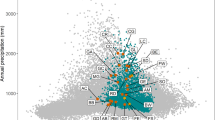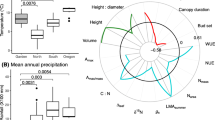Abstract
The genus Populus is currently the main model system for genetic, genomic, and physiological research in trees. Phenotypic variation in aspen (Populus tremula) populations growing in different environments across Sweden is expected to reflect genetic variation that is important for local adaptation. To analyze such natural phenotypic and genetic variation, the Swedish Aspen (SwAsp) Collection was established. Trees were taken from 12 different populations across Sweden, from 56° to 66° latitude north and planted in two common gardens in Ekebo (55.9°N) and Sävar (63.4°N). Data related to phenological and growth traits were collected during the second year of growth. Some traits like the date of bud set and leaf area duration showed strong clinal variation patterns with latitude in both field trials, but the date of bud flush did not change along a latitudinal cline. The phenological traits showed moderate within-populations heritabilities, although growth traits showed weaker clinal patterns and lower heritabilities than the phenological traits. This research forms the starting point for the development of the SwAsp collection, a resource facilitating analysis of the natural genetic variation in aspen, the elucidation of the structure and dynamics of aspen populations, and the future identification of the genes controlling adaptive traits using association mapping of selected candidate genes.








Similar content being viewed by others
References
Alonso-Blanco C, Koornneef M (2000) Naturally ocurring variation in Arabidopsis: an underexploited resource for plant genetics. Trends Plant Sci 5:22–29
Andersson A, Keskitalo J, Sjödin A, Bhalerao RR, Sterky F, Wissel K, Tandre K, Aspeborg H, Moyle R, Ohmiya Y, Bhalerao RP, Brunner A, Gustafsson P, Karlsson J, Lundeberg J, Nilsson O, Sandberg G, Strauss S, Sundberg B, Uhlen M, Jansson S, Nilsson P (2004) A transcriptional timetable of autumn senescence. Genome Biol 5:R24
Arora R, Rowland LJ, Tanio K (2003) Induction and release of bud dormancy in woody perennials: a science comes of age. HortScience 38:911–921
Bhalerao RR, Keskitalo J, Sterky F, Erlandsson R, Björkbacka H, Birve S, Karlsson J, Gardeström P, Gustafsson P, Lundeberg J, Jansson S (2003) Gene expression in autumn leaves. Plant Physiol 131:430–442
Böhlenius H, Huang T, Charbonnel-Campaa L, Brunner AM, Jansson S, Strauss SH, Nilsson O (2006) CO/FT regulatory module controls timing of flowering and seasonal growth cessation in trees. Science 312:1040–1043
Box GEP, Tiao GC (1973) Bayesian inference in statistical analysis. Addison-Wesley, Reading, UK
Bradshaw HD, Stettler RF (1995) Molecular genetics of growth and development in Populus.IV. Mapping QTLs with large effects on growth, form and phenology traits in a forest tree. Genetics 139:963–973
Bradshaw HD, Ceulemans R, Davis J, Stettler R (2000) Emerging model systems in plant biology: poplar (Populus) as a model forest tree. J Plant Growth Regul 19:306–313
Brissette JC, Barnes BV (1984) Comparisons of phenology and growth of Michigan and western North American sources of Populus tremuloides. Can J Forest Res 14:789–793
Brunner AM, Busov VB, Strauss SH (2004) Poplar genome sequence: functional genomics in as ecologically dominant plant species. Trends Plant Sci 9:49–56
Chen THH, Howe GT, Bradshaw HD Jr (2003) Molecular genetic analysis of dormancy related traits in poplars. Weed Sci 50:232–240
Cronk QCB (2005) Plant eco-devo: the potential of poplar as a model organism. New Phytol 166:39–48
Dunlap JM, Stettler RF (1996) Genetic variation and productivity of Populus trichocarpa and its hybrids. IX. Phenology and Melampsora rust incidence of native black cottonwood clones from four river valleys in Washington. For Ecol Manag 87:233–256
Farmer RE (1993) Latitudinal variation in height and phenology of balsam poplar. Silvae Genet 42:148–153
Frewen BE, Chen THH, Howe GT, Davis J, Rohde A, Boerjan W, Bradshaw HD (2000) Quantitative trait loci and candidate gene mapping of bud set and bud flush in Populus. Genetics 154:837–845
Gelman AJ, Carlin JB, Stern HS, Rubin D (1995) Bayesian data analysis. Chapman & Hall, London
Gilchrist EJ, Haughn GW, Ying CC, Otto S, Zhuang J, Cheung D, Hamberger B, Aboutorabi F, Kalynyak T, Johnson L, Bohlmann J, Ellis BS, Douglas CJ, Cronk QCB (2006) Use of Ecotilling as an efficient SNP discovery tool to survey genetic variation in wild populations of Populus trichocarpa. Mol Ecol 15:1367–1378
Håbjørg A (1972) Effects of photoperiod and temperature on growth and development of three latitudinal and three altitudinal populations of Betula pubescens Ehrh. Institute of Dendrology and Nursery Management, Agricultural University of Norway, Report No 44, 51:1–27
Howe GT, Hackett WP, Furnier GR, Klevorn RE (1995) Photoperiodic responses of a northern and southern ecotype of black cottonwood. Physiol Plant 93:695–708
Howe GT, Gardner G, Hackett WP, Furnier GR (1996) Phytochrome control of short-day induced bud set in black cottonwood. Physiol Plant 97:95–103
Howe GT, Saruul P, Davis J, Chen THH (2000) Quantitative genetics of bud phenology, frost damage, and winter survival in a F2 family of hybrid poplars. Theor Appl Genet 101:632–642
Hultén E, Fries M (1986) Atlas of North European vascular plants: north of the tropic of cancer I–III. Koeltz Scientifics Books, Königstein
Ingvarsson PK (2005) Nucleotide polymorphisms and linkage disequilibrium within and among natural populations of European aspen (Populus tremula L, Salicaceae). Genetics 169:945–953
Ingvarsson PK, Garcia MV, Hall D, Luquez V, Jansson S (2006) Clinal variation in phyB2, a candidate gene for day-length induced growth cessation and bud set, across a latitudinal gradient in European aspen (Populus tremula). Genetics 172:1845–1853
Jackson JE (2003) A user’s guide to principal components. Wiley, Hoboken, NJ
Jalas J, Suominen J (1989). Atlas florae europaeae: distribution of vascular plants in Europe, vol 3. Cambridge University Press, Cambridge
Koornneef M, Alonso-Blanco C, Vreugdenhil D (2004) Natural occurring genetic variation in Arabidopsis thaliana. Ann Rev Plant Biol 55:141–172
Koski V, Sievänen R (1985) Timing of growth cessation in relation to the variations in the growing season. In: Tigersted P, Puttonen P, Smolander H (eds) Crop physiology of forest trees. Helsinki University Press, Helsinki, pp 167–193
Lynch M, Walsh B (1998) Genetics and analysis of quantitative traits. Sinauer, Sunderland, MA
Neale DB, Savolainen O (2004) Association genetics of complex traits in conifers. Trends Plant Sci 9:325–330
Olsen JE, Junttila O, Nilsen J, Erickson ME, Martinussen I, Olsson O, Sandberg G, Moritz T (1997) Ectopic expression of oat phytochrome A in hybrid aspen changes critical daylength for growth and prevents cold acclimatization. Plant J 12:1339–1350
Pauley SS, Perry TO (1954) Ecotypic variation of the photoperiodic response in Populus. J Arnold Arbor 35:167–188
Pinheiro JC, Bates DM (2000) Mixed-effects models in S and S-PLUS. Springer, Berlin Heidelberg New York
Pryor LD, Willing RR (1965) The development of poplar clones suited to low latitudes. Silvae Genet 14:123–127
Rafalski A (2002) Applications of single nucleotide polymorphisms in crop genetics. Curr Opin Plant Biol 5:94–100
Riemenschneider DE, McMahon BG, Ostry ME (1992) Use of selection indices to increase tree height and to control damaging agents in 2-year-old balsam poplar. Can J For Res 22:561–567
Riemenschneider DE, Mc Mahon BG, Ostry ME (1994) Population-dependent selection strategies needed for 2-year-old black cottonwood clones. Can J For Res 24:1704–1710
Searle SR (1961) Phenotypic, genetic and environmental correlations. Biometrics 17:474–480
Sterky F, Bhalerao RR, Unneberg P, Segerman B, Nilsson P, Brunner A, Charbonnel-Campaa L, Jonsson-Lindvall J, Tandre K, Strauss SH, Sundberg B, Gustafsson P, Uhlén M, Bhalerao RP, Nilsson O, Sandberg G, Karlsson J, Lundeberg J, Jansson S (2004) A Populus EST database for plant functional genomics. Proc Natl Acad Sci USA 101:13951–13956
Taylor G (2002) Populus: Arabidopsis for Forestry. Do we need a model tree? Ann Bot 90:681–689
Tuskan GA et al (2006) The Genome of black cottonwood, Populus trichocarpa (Torr. & Gray). Science 313:1596–1604
Weber JC, Stettler RF, Heilman PE (1985) Genetic variation and productivity of Populus trichocarpa and its hybrids. I. Morphology and phenology of 50 native clones. Can J For Res 15:376–383
Welling A, Moritz T, Tapio Palva E, Juntilla O (2002) Independent activation of cold acclimation by low temperature and short photoperiod in hybrid aspen. Plant Physiol 129:1633–1641
Whitehead FH, Myerscough PJ (1962) Growth Analysis of Plants. The ratio of mean relative growth rate to mean relative rate of leaf area increase. New Phytol 61:314–321
Wullschleger SD, Jansson S, Taylor G (2002) Genomics and forest biology: Populus emerges as the perennial favorite. Plant Cell 14:2651–2655
Yu Q, Mäntyla N, Salonen M (2001) Rooting of hybrid clones of Populus tremula L. X P. tremuloides Michx. By stem cuttings derived from micropropagated plants. Scand J For Res 16:238–245
Acknowledgments
We are indebted to the staff at Skogforsk in Ekebo and Sävar and to the local “Skogsvårdsstyrelser” who have been instrumental in the creation of the SwAsp collection. This work was supported by grants from the Kempe Foundation, the Foundation for Strategic Research, and the Swedish Research Council.
Author information
Authors and Affiliations
Corresponding author
Additional information
Communicated by W. Boerjan
Electronic supplementary material
Below is the link to the electronic supplementary material
Rights and permissions
About this article
Cite this article
Luquez, V., Hall, D., Albrectsen, B.R. et al. Natural phenological variation in aspen (Populus tremula): the SwAsp collection. Tree Genetics & Genomes 4, 279–292 (2008). https://doi.org/10.1007/s11295-007-0108-y
Received:
Revised:
Accepted:
Published:
Issue Date:
DOI: https://doi.org/10.1007/s11295-007-0108-y




